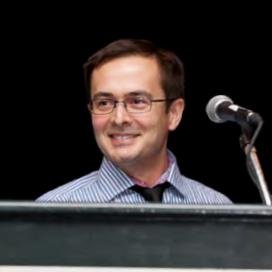From Collision Prediction Models to Revenue Analytics: How Alumnus Jeremy Adamson is Using a Multidisciplinary Skillset to Build A Challenging Career
Author: Engineering Alumni Office
Posted on Jul 18, 2017
Category: Alumni Spotlight
Jeremy Adamson (BScCE’10, MEng’13) has always chased challenges. After growing up in Harvey, New Brunswick, he moved to Fort McMurray and started his own web development business, even though his father and grandfather were engineers and it would have been a natural path for him to take.

When he did eventually decide to return home and attend UNB, he not only earned a civil engineering degree but also a diploma in Technology Management & Entrepreneurship (TME). He then went directly into studying for a Master of Engineering at the University of Waterloo, but the challenge of working in the field beckoned, and he soon set off for Lethbridge as an Infrastructure Management Systems Engineer for Alberta Transportation. Thanks to Dr. Eric Hildebrand, he was permitted to switch to the MEng program in Civil Engineering at UNB part-time, studying remotely. During the next two years, he took on increasingly advanced projects at work, completed research projects, took on the roles of VP of the student ITE chapter and editor of the engineering newspaper, and graduated as Valedictorian in Transportation Engineering.
Since that time he’s made leaps and bounds in his career, but not in transportation engineering. He spent a year at Suncor Energy developing forecasting models to guide investments by the company and was then recruited by WestJet to lead a team generating revenue analytics. “The mathematics I previously used to predict collisions was the same used to identify revenue opportunities based on predicted behaviours”, he explained. “The tech and skills really translated well.”
But Jeremy didn’t stop there. While working he completed an Executive MBA at the University of Calgary, at the same time as raising one child and having a second with his wife, Melodie. The most recent move for Jeremy was to Manulife’s head office in Waterloo earlier this year, where he took on the role of Director of Experience and Predictive Analysis. “There’s been a lot of disruption in the insurance industry, and the big players are looking to innovative tech and predictive analytics to keep up.”
Jeremy says that the combination of engineering and business education has been instrumental in helping him succeed. “My technical background allowed me to add value to the companies I’ve worked for very quickly, and the TME and MBA courses helped me become a strategist and a leader. Because of my engineer training I use a lot of Gantt charts that help with time and project management and allocation of resources. The multidisciplinary background provides a framework for innovative ideas and new approaches to problems.”
He’s also passionate about investing in individuals to build engaged teams and future leaders. He feels strongly that life-long learning is important, as is mentorship and helping others grow and succeed. He’s mentored engineering students through APEGA, and recently returned to UNB to give a lecture as part of the Transportation Seminar Series (the oatcakes from the Head Rest may have also enticed him).
So what’s the next challenge? Hong Kong. Most of Manulife’s business is in Asia, and Jeremy is eyeing a position that would take him to the heart of it. It’s a long way from small-town NB, but the predictive analysis model based on past behaviour shows a positive outcome.
